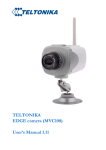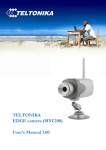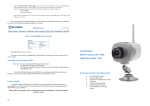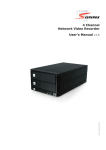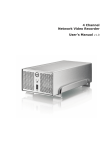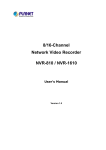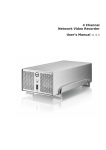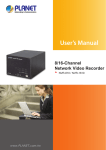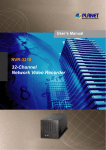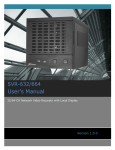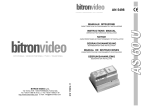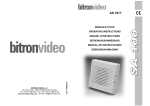Download TELTONIKA EDGE camera (MVC100) User`s Manual 1.10
Transcript
TELTONIKA EDGE camera (MVC100) User’s Manual 1.10 LEGAL NOICE Copyright © 2009 TELTONIKA Ltd. All rights reserved. Reproduction, transfer, distribution or storage of part or all of the contents in this document in any form without the prior written permission of TELTONIKA Ltd is prohibited. Other product and company names mentioned herein may be trademarks or trade names of their respective owners. ATTENTION Do not rip the device. Do not touch the device if the device block is broken or its connecting wires are without isolation. All wireless devices for data transferring may be susceptible to interference, which could affect performance. The device is not water-resistant. Keep it dry. The device requires high 230V AC voltage. Only qualified personnel may install or repair this product IMPORTANT NOTES! It is mandatory to read the notes and manual carefully before starting to use the device. 2|Page Table of Contents SAFETY INFORMATION ................................................................................................................................................ 4 1 GETTING STARTED.............................................................................................................................................. 5 1.1 INTRODUCTION ......................................................................................................................................................... 5 1.2 PACKAGE CONTENTS ................................................................................................................................................... 5 1.3 INSTALLING THE HARDWARE ......................................................................................................................................... 5 1.3.1 Inserting SIM card ....................................................................................................................................... 5 1.3.2 Attaching antenna....................................................................................................................................... 6 1.3.3 Back panel overview .................................................................................................................................... 6 1.3.4 2-pin terminal block .................................................................................................................................... 7 1.3.5 5-pin terminal block .................................................................................................................................... 7 1.3.6 Wall mounting ............................................................................................................................................. 7 1.4 CAMERA ACCESS SOFTWARE AND DRIVERS ...................................................................................................................... 8 1.4.1 Installing the software and drivers (Windows XP only) ............................................................................... 8 1.4.2 Uninstalling the Driver and Software ........................................................................................................ 10 1.4.3 Using Camera Connection (CCT) Tool ........................................................................................................ 10 1.5 ACCESSING THE CAMERA ........................................................................................................................................... 11 1.5.1 Accessing WEB interface ........................................................................................................................... 11 1.5.2 WEB configuration page interface structure ............................................................................................. 11 1.6 SETTING CAMERA’S GSM CONNECTION ....................................................................................................................... 12 1.7 ACCESSING CAMERA FROM THE WEB .......................................................................................................................... 13 1.7.1 SIM card with public static IP address ....................................................................................................... 13 1.7.2 SIM card with public dynamic IP address .................................................................................................. 13 2 EDGE CAMERA CONFIGURATION ..................................................................................................................... 14 2.1 STATUS & REVIEW ................................................................................................................................................... 14 2.1.1 Live view .................................................................................................................................................... 14 2.1.2 Playback .................................................................................................................................................... 15 2.2 VIDEO AND IMAGE SETTINGS ...................................................................................................................................... 16 2.2.1 Video parameters ...................................................................................................................................... 16 2.3 EVENT CONFIGURATION ............................................................................................................................................ 17 2.3.1 Stream & Events ........................................................................................................................................ 17 2.3.2 On Call function ......................................................................................................................................... 19 2.4 SETTINGS ............................................................................................................................................................... 20 2.4.1 E-mail & FTP .............................................................................................................................................. 20 2.4.2 Network ..................................................................................................................................................... 21 2.5 ADMIN .................................................................................................................................................................. 23 2.5.1 Logs ........................................................................................................................................................... 23 2.5.2 Users management ................................................................................................................................... 23 2.5.3 Maintenance ............................................................................................................................................. 25 2.6 RESTORING DEFAULT USERNAME AND PASSWORD OR RESETTING TO FACTORY DEFAULTS ........................................................ 26 3 TYPICAL PIR AND DOOR SENSOR CONNECTION ................................................................................................ 26 4 TROUBLESHOOTING ......................................................................................................................................... 27 4.1 4.2 CAN NOT CONNECT TO THE CAMERA WEB CONFIGURATION PAGE ..................................................................................... 27 CAMERA DOES NOT CONNECT TO GSM NETWORK .......................................................................................................... 27 5 TECHNICAL SPECIFICATION............................................................................................................................... 28 6 APPENDIX A INSTALLING MPEG4 CODEC FOR THE PC ....................................................................................... 30 3|Page SAFETY INFORMATION In this document you will be introduced how to use camera safely. We suggest you to adhere to following recommendations to avoid any damage to person or property. You have to be familiar with the safety requirements before starting to use the device! Camera is used for transmission of video and single images via GSM network using GPRS and EDGE technologies. To avoid burning and voltage caused injuries, of the personnel working with device, please follow these safety requirements. Installation and technical support of the camera device can be performed only by a qualified personnel or a person who has enough knowledge about this device and safety requirements. Camera device requires 12V 250 mA constant power supply source that satisfies all safety requirements listed in LST EN 60950-1 standard. The PC and power supply source, to which the device is connected, should satisfy LST EN 60950-1 standard. The device can be used on first (Personal Computer) or second (Notebook) computer safety class. The light or attachable sensors must satisfy all safety requirements listed in LST EN 60950-1 standard. Disconnect device from power supply before mounting to avoid voltage effect! Do not mount or serve device during a thunderbolt. To avoid mechanical damages of the device it is recommended to transport the device packed in damage-proof pack. While using the device, it should be placed so, that its indication LED would be visible as they inform in which working mode the device is and if it has any working problems. Protection against over currents, short circuits and earth faults should be provided as a part of the building installation. Two pole protective device is required to protect from short-circuit and earth false. The power of connected device should satisfy power of release device. To disconnect the device plug off AC/DC power adapter from the wall outlet or power strip. The interstice between contacts should be no less than 3mm. Signal level of the device depends on the environment in which it is working. If the device starts working insufficiently only qualified personnel may repair this product. We recommend to forward it to repair centre or to manufacturers. No exchangeable parts inside of the device. 4|Page 1 GETTING STARTED 1.1 Introduction Teltonika MVC100 EDGE Camera is a compact mobile surveillance and monitoring system for transmission of high resolution video and single images via GPRS/EDGE network. In places with no land line Internet available MVC100 is ideal for remote surveillance and monitoring of temporary or distant sites or mobile assets. The images can be acquired automatically with programmable period and/or upon external triggers such as motion sensors or door contacts. The video and single images can be viewed on a PC or a handheld device, and can also be transmitted to FTP-server and/or by email. 1.2 Package contents MVC100 EDGE Camera External GSM antenna AC/DC Power adapter (Euro or UK) USB cable Angled wall mount bracket Leaflet “Quick Start Guide” CD with software, drivers and manual Note: The manufacturer does not supply the SIM card, which is mandatory for setting up a connection to the GSM network! The SIM card may be purchased from your GSM (mobile) service provider! Note: If any of the components is missing or damaged, please contact the retailer or reseller from which this product was purchased. 1.3 Installing the hardware Before installing the hardware, check to make sure that all items listed in the package contents are in. 1.3.1 Inserting SIM card Open and remove the back panel of the camera. To do that, use the screw-driver to unscrew four screws holding panel. After the back panel is removed gently insert the SIM card as showed in figures below. Before inserting SIM card do not forget to remove SIM card PIN code request. Otherwise you will not be able to connect to GSM network. 5|Page Insert the SIM card into the holder with the metal contacts facing to the SIM connector side. Ensure that the „cut-off‟ corner is at the bottom right as in figure above. After the SIM card is inserted attach the panel to its previous position. 1.3.2 Attaching antenna Screw the antenna in a clockwise direction. Position the antenna upwards at its connecting joint. This will ensure optimal reception. 1.3.3 Back panel overview 1. 2. 3. 4. 5. 6. 7. 8. 9. 10. Figure 1. EDGE camera back panel view. Power supply adapter socket. Battery on/off switcher 5-pin terminal block 2-pin terminal block for connecting external light MicroSD card socket Power LED GPRS/EDGE conn. status LED Ready LED USB socket GSM antenna connector Table 1. EDGE camera back panel view. LED Colour Solid Off Power Green Power ON Power OFF GPRS/EDGE conn. status Green Connected No connection Ready Green Ready to work Booting 6|Page 1.3.4 2-pin terminal block Internally 2-pin terminal block is connected to relay inside the camera (refer to Fig. 2.). The connector may be used for connecting external light, which may be turned on event. Normally relay contact stay open. On event for the predefined time of period contact maybe closed causing to turn on the light. How enable this feature refer to section “2.3 Event configuration”. The maximum allowed current - 5A, maximum allowed voltage - 24V. Camera Relay 2-pin terminal block Figure 2. Internal camera relay connected to 2-pin terminal block. 1.3.5 5-pin terminal block The 5-pin terminal block may be used for connecting external alarm sensor or for enabling infrared light source. Most common used sensor examples are given in section “4 Typical PIR and door sensor connection”. The Table 2 provides 5-pin terminal block description. Table 2. 5-pin terminal block pin out description. Signal Type Description Vcc Power, output Power supply output. Output voltage depends on operated power supply source: battery 9V, 0.5 A mains supply 11-12V, 0.5 A IRLED Output (Optional) 3.3V power supply source for enabling infrared light source. Internal output resistance 1k Ω C1 Input Sensor signal input, 0 - 3.3V, internal pull up 4.7k Ω C2 Input Sensor signal input, 0 - 3.3V, internal pull up 4.7k Ω GND Power, ground Power and signal ground. 1.3.6 Wall mounting The camera is packed with attachable wall mounting bracket. Wall mounting bracket through the holes on the bracket pad may be attached to the wall. Figure 3. Attaching wall mount bracket to the camera. 7|Page 1.4 Camera access software and drivers 1.4.1 Installing the software and drivers (Windows XP only) To start using first EDGE Camera drivers and software must be installed: Connect power supply to the camera, then connect camera to the USB port. Insert the CD supplied with the camera into CD-ROM drive of your PC. The CD will start up automatically opening installation window. If the window does not appear, run setup.exe file located in the CD. Follow the instructions to install drivers and software for the MVC100. Step 1 Step 4 Step 3 Step 2 Step 6 Step 5 Step 8 Step 7 8|Page Note: The installation software installs FTDI company USB drivers. If FTDI drivers to PC have never been installed before Windows New Hardware Wizard window may appear. To finish the installation choose Yes this time only, click Next, then choose Install the software automatically (Recommended) and to all other windows simply click Next. 1.4.2 Connecting to the EDGE Camera with Camera Connection Tool (CCT) 1. 2. 3. 4. Unplug camera power supply and USB. Connect power supply to the camera, then connect camera to the USB. Wait for power and ready LED lights up. Start CCT (Camera Connection Tool). To start it go: Start => Programs => Teltonika => MVC100 Camera => Camera Connection Tool 5. Press Connect button. 9|Page 6. Press the Show default camera page button to Start your Internet browser (e.g. IE or Mozilla) with default IP address http://10.0.0.1 (Make sure that cookies are enabled on your browser). Enter the login username and password. The default administrator login settings are: Login: admin Password: admin Note: if a Hardware Installation warning appears informing that Teltonika Camera has not passed Windows Logo testing to verify its compatibility with Windows XP, press Continue Anyway. 1.4.3 Notes for using Camera Connection (CCT) If you are going disconnect the USB cable or power supply from the camera, click “Disconnect” in the CCT window, wait until the message “Disconnected” appears and click “Connect” when you will connect USB to the same camera. If you are going to connect another EDGE camera to the PC close the CCT tool, unplug the camera form the PC, connect the other camera to the PC and make connection using CCT again. If any problem occurs with the connection close the CCT, unplug the camera from the PC USB port, then connect the camera to the PC and make connection using CCT again. If the problem persists, close CCT, open Start ->Control Panel ->System->Hardware->Device Manager, expand “Modems”, right-click on “Teltonika Camera” and uninstall it. Unplug the power supply and the USB cable from the camera. Then connect the camera to the PC and make connection using CCT again. 1.4.4 Uninstalling the Driver and Software To uninstall the driver and software follow these instructions: 1. Disconnect the Camera from the PC USB port. 2. Select Start => Programs => Teltonika => MVC100 Camera, click on Uninstall and then follow instructions. Note: alternatively driver and software may be removed from Control Panel: Start => Settings => Control Panel => Add or Remove Programs. From the list select Teltonika MVC100 Camera and then click Remove. 10 | P a g e 1.5 Accessing the Camera 1.5.1 Accessing WEB interface To access camera WEB interface firstly connect to the camera using CCT tool. After successful connection open the Web browser and type the camera IP address (http://10.0.0.1). Also make sure that cookies are enabled on your browser. If the camera port was changed from default port 80 to another value the IP address must be written in from http://10.0.0.1:1010 (Value 1010 is new port). If the IP address and port are correct the login page asking for username and password appears: The default administrator login settings are: Login: admin Password: admin 1.5.2 WEB configuration page interface structure The welcome page of the Web management page after successful login to the camera (Fig. 4) is displayed. From this menu all essential configuration pages are accessed. Figure 4. Welcome page of the camera WEB interface Status & Review Live view – real time camera view Playback – review stored video or snapshot pictures Video and image settings Video parameters – adjust contrast and brightness Event configuration Stream & Events – configure constant video and video on event On call – configure on call events and area listening feature Settings E-mail & FTP – configure E-mail and FTP settings Network – configure mobile network and DDNS settings Admin Logs – displays system logs User’s management – add/ remove new users, change user‟s login details Maintenance – set the time or update the camera firmware 11 | P a g e 1.6 Setting camera’s GSM connection To set up the GSM connection SIM card is required. SIM card is not supplied with the camera. It may be purchased from GSM service provider. To set up the connection the following information from your GSM provider is required: 1. Phone number. Most often used for all GSM service providers is *99#. 2. PPP authentication. The authentication protocol, which is used by your Internet Service Provider [None, CHAP or PAP]. 3. APN. Access Point Name (APN). 4. User Name. If GSM operator does not require username, leave it blank. 5. Password. If GSM operator does not require password, leave it blank. 6. DNS server 1. If GSM operator does not require DNS server 1, leave it blank. 7. DNS server 2. If GSM operator does not require DNS server 2, leave it blank. Note: from DNS servers section drop down menu choose option Custom, in order to set DNS servers. !!!Do not forget to remove SIM card PIN code request. Otherwise you will not be able to connect to GSM network. After all the connection data from your GSM provider is collected, connect to the camera WEB interface. Then select Network tab (refer to Fig. 5). Figure 5. Mobile network configuration. Set up Network settings with data from internet service provider. The Web server (camera) port is advised to leave 80. After setting all GSM connection information pres Save button. Camera will reboot and startup with new settings. 12 | P a g e 1.7 Accessing Camera from the WEB There are two ways to connect the EDGE camera from internet: 1. Use SIM card with public static IP address 2. Use SIM card with public dynamic IP address witch will be linked to static hostname using DDNS service. Note: If the SIM card is with private IP address then reaching camera from the internet is not possible as connection is routed through a NAT firewall in your provider‟s network. 1.7.1 SIM card with public static IP address Open your WEB browser and type SIM card IP address, when the camera GSM connection has been set up. After successful connection camera‟s login page must appear. Note: If the Web server (camera) port has been changed in the Network settings then IP address should be written in the following form: https://A.A.A.A:B, where A.A.A.A is the camera IP address and B the Camera Web server port. 1.7.2 SIM card with public dynamic IP address For the SIM card with dynamic public IP address the IP address is given for a limited period of time, which is usually no more than a few hours, then the IP address is changed. As he IP address is continuously changed it becomes a problem to connect to the camera. To solve this problem Dynamic Domain Name Service (DDNS) may be used. DDNS is a domain name service allowing to link dynamic IP addresses to static hostname. To start using this feature firstly a hostname must be registered on the DDNS server. The camera is preconfigured to connect to the www.dyndns.com server for updating camera IP address. After creating account at www.dyndns.com you will get: Hostname Username and Password. To link camera‟s IP address to the static hostname, Dynamic DNS settings must be configured. To configure DDNS connect to the camera WEB configuration page, go the Network tab (Fig. 6). Figure 6. DDNS settings Check the Enable check box. Enter username, password and hostname which where got from the DDNS server provider. In the Update interval field enter the IP address update interval. After setting DDNS settings press Save button. Camera will reboot and startup with new settings. 13 | P a g e 2 EDGE CAMERA CONFIGURATION 2.1 Status & Review 2.1.1 Live view The live view section allows seeing video in real time within the camera WEB interface. Also it contains important status information. The status information view is shown in Fig. 7. Figure 7. Status information GSM operator – Displays the GSM operator Logo to which camera is connected. Connection strength – Displays received signal connection strength. IP – Camera IP number. IMEI – Camera IMEI number. Mains – Shows mains power supply status. Battery status – Shows battery energy status. Live View settings allow setting the desired resolution, quality and format (refer to Fig. 8). Figure 8. Live view settings Resolution – Select the desired resolution of live view [VGA/QVGA/QQVGA]. Quality – Select display video quality. [Basic/Medium/Normal/High/Best]. Video format – Displays allowable video format [JPEG]. Live view session time is set in the section “Live view time out”. When the time expires camera stops displaying live view. Live view can be started again by pressing Reset button. Figure 9. Live view timeout settings Time remaining – Displays remaining time before camera stops displaying live view. Timeout – Define the time out in minutes and seconds. 14 | P a g e 2.1.2 Playback Many security applications require recording the video or snapshots that may be reviewed later. The MVC100 allows not only sending media content over internet to distant FTP servers or to emails but also to record it locally in the internal Cameras memory or to the SD card. If there is no SD card installed only up to 10 snapshots that are generated on events are recorded. The video streams are not recorded to the internal camera memory. Recorded video or snapshots may be reviewed in the Playback section (Refer to Figure 10). Figure 10. Choose Playback to review media stored in the camera‟s internal memory. The stored media is grouped according to the date (See Figure 10). For easer review year, month, day or time maybe selected to regroup the media. Media type denotes the type of the record: Video: MPEG4 video clip Images: series of JPG images Image: single JPG image The records may be reviewed browsing to the desired record using „Next page“, „Previous page” or dropdown page list. In the case of MPEG4 video clip („Video“) click „Play“ or „Download“ to download the video (Figure 11) 15 | P a g e Figure 11. MPEG4 playback window If the MPEG4 video file doesn't play, MPEG4 codec must be installed from the supplied CD. How to install the codec please refer to Appendix A Installing MPEG4 codec for the PC. 2.2 Video and image settings 2.2.1 Video parameters Video parameters may be used to get clear video display. Fig. 12 shows video configurations settings. Figure 12. Video settings configuration. Brightness – Adjust the brightness value from range -127 to 127. Contrast – Adjust the contrast value from range 0 to 127. Pressing Save button updates camera with new settings immediately. However these settings are stored in temporary memory which is cleared after plugging off the power or rebooting causing camera to restore default parameters values. 16 | P a g e 2.3 Event configuration 2.3.1 Stream & Events Camera may be configured to record a constant video stream or make a record triggered by event. A common event type is an alarm on connected external sensor to camera that causes the camera to upload images. The configuration menu allows choosing the quality and the resolution. The lower quality and resolution the smaller is the frame size. Approximate frame size values for the VGA resolution are: Best => 50 kBytes High => 40 kBytes Normal => 30 kBytes Medium => 20 kBytes Basic => 10 kBytes QVGA frame size is about 4 times smaller than VGA. QQVGA frame size is about 16 times smaller than VGA. Choosing the quality and resolution value is very important as EDGE transmission rate is limited. The camera allows sending data up to 236 kbits/s. The actual transmitted data speed depends on GSM provider‟s network and GSM signal strength. 2.3.1.1 Constant stream Constant stream allows configuring constant video sending to FTP or by E-mail. Before enabling this feature do not forget to set parameters for FTP in E-mail in the E-mail & FTP tab in camera web configuration page. In order to receive constant video by FTP and E-mail do not forget to set reasonable values for frame speed, resolution and quality as data transmission is limited by the EDGE connection speed. Figure 13. Constant video stream settings. Enable – Check the box to enable constant stream. Resolution – Select the desired resolution of live view [VGA/QVGA/QQVGA]. Quality – Select display video quality. [Basic/Medium/Normal/High/Best]. Frame rate – Set frame rate for video stream. Video format – Displays allowable video format [JPEG]. Send to – Select video stream sending destination. Pressing Save button updates camera with new settings immediately. These settings are stored in permanent memory. 17 | P a g e 2.3.1.2 On event stream Figure 14. Event video stream settings. Enable – Check the box to enable stream on event feature. Events – Select desired events which trigger the camera. Event trigger maybe be: Contact1, Contact2 which are located on the back panel of the camera. Connect external sensors (e.g. door, PIR) to these contacts. Resolution – Select the desired resolution of live view [VGA/QVGA/QQVGA]. Quality – Select display video quality [Basic/Medium/Normal/High/Best]. Frame rate – Set frame rate for video stream. Checking Single shot check box allows to record single shot. Video format – Displays allowable video format [JPEG]. Send to – Select video stream send destination. To send video to E-mail or FTP their settings first must configured. If the Output option is selected camera will close relay contact on 2-pin terminal block. This terminal maybe connected to the light source. Triggering the camera will cause relay to work as light switch for lighting up the external light. Pre-alarm – The camera has ability to send stream which was before the event. It is made by continuously storing required amount of information in camera‟s internal memory. Set the time in seconds to define how much data must be stored. This function is very useful when checking to see what happened immediately before a trigger. Send-alert – select this option to enable sending alert message. Message will be sent if an event on contacts Contact1 or Contact2 will be generated. The SMS messages will be sent to all the mobile phones that are in the user‟s lists. Users list if configured in Users management section. Post-alarm – Set the time in seconds how long after the event camera sends the stream. Output duration – Camera has integrated relay switch, which may be turned on event. Set the time to define relay closed contact time. Pressing Save button updates camera with new settings immediately. These settings are stored in permanent memory. In order to test if camera transmits defined stream on event to E-mail, FTP or Output the Generate button may be pressed. It is a useful feature allowing easily testing system work. Note: camera can capture up to 40 frames. Please choose correct frame rate and Pre-alarm and Post-alarm values in order to do not exceed the 40 frame limit. 18 | P a g e 2.3.2 On Call function 2.3.2.1 On Call function On Call settings allow configuring camera‟s response when phone call or SMS command is received. These settings can be set only by Administrator‟s user class. Phone call or SMS commands are accepted only from the authorized users' phone number. Authorized users are configured in the Users management section. Area listening feature may be accessed by all types of user classes: Administrator, User and Guest. Figure 15. On call event Settings. Enable – Check the box to enable “On call” function. Send email - Check the box to send snapshot or video clip to authorized user email to its email. Email address is configured in the Users management section. Turn voice on - Check the box to activate area listening feature. This feature allows to listen surrounding are by making a phone call to the camera. Turn voice on after – threshold of beep (ring) count (1 beep = 5s). To request image or clip from camera, make a call shorter then defined number of beeps. Make a call longer then defined number of beeps, to activate “area listening” feature. Resolution –Select desired resolution of the image or video clip [VGA/QVGA/QQVGA]. Quality – Select video quality. [Basic/Medium/Normal/High/Best]. Single shot – Check the box if only single frame is needed. Frame rate – Set frame rate for the video stream. Video format – Select video format [MJPG, MPEG4]. Video duration – video clip duration. 2.3.2.2 SMS commands Camera allows reaching some of it features using SMS. The messages are accepted only by Administrator and User class users. If the SMS sender‟s phone is not in the users list it will be ignored by the camera. Command apn, pn Users class Administrator Example apn operator_apn pn *99# img Administrator, user Administrator, user Administrator, user img img email alarm on img email alarm on Action Sets provider APN and phone number. After the camera receives SMS it changes its settings, sends SMS confirmation SMS to the senders and reboots. In order to test camera remotely the SMS maybe sent to generate event. Camera sends snapshot taken when SMS is received to the user‟s email from which SMS is received. Camera enables “On event stream” and sends confirmation SMS to the sender. 19 | P a g e Command alarm off Example alarm off cb Users class Administrator, user Administrator, user Administrator cu Administrator cu up? Administrator, user Administrator, user up? alarm? ipaddr? alarm? cb ipaddr? Action Camera disables “On event stream” and sends confirmation SMS to the sender. Camera sends “On event stream” status: enabled or disabled. The camera allows remote listening in on surrounding area by making the phone call. Sending SMS with “cb” commands stops the call. The camera sends SMS message with information about current or last “area listener” user. The camera sends SMS with information what is sender‟s user‟s class. The camera sends SMS message with its IP address to the sender. 2.4 Settings 2.4.1 E-mail & FTP This section describes how to configure FTP and E-mail settings. Settings can be found at the E-mail and FTP tab in camera WEB configuration page. Pressing Save button updates camera with new settings immediately. These settings are stored in permanent memory. Figure 16. E-Mail settings. SMTP server – the domain or the IP address of the email SMTP server. User name –Enter your user name of the email account. Password – Enter your password of the email account. Sender’s email address – Enter emails address which is assigned to the username and password. Receiver’s email address – Enter email address of the recipient to which the video or single images will be sent. CC email – Enter secondary recipients email address which will be added to the sent e-mail as Carbon Copy (CC). Subject – Enter the desired subject of the email. 20 | P a g e Figure 17. FTP settings. Host address – the domain or the IP address of the FTP server. User name –Enter your user name of the FTP account. Password – Enter your password of the FTP account. Port – Set the port of the FTP server. The default FTP port is 21. Path – Set the folder path to with the data will be transferred. 2.4.2 Network 2.4.2.1 GSM network settings The Network settings section is used to configure connection to GSM network. All the configuration data except the Web server (camera port) must be provided by your mobile service provider. !!!Do not forget to remove SIM card PIN code request. Otherwise you will not be able to connect to GSM network. Figure 18. Mobile network configuration. Phone Number – Phone number acquired from your ISP (default *99#). PPP authentication – select authentication protocol, which is used by your Internet Service Provider [None/CHAP/PAP]. APN – Access Point Name (APN). User Name – Enter your User Name for your mobile connection. Password – Enter your Password for your mobile connection. PIN – SIM card pin number. DNS server 1 and DNS server 2 are ISP domain servers. Web server (camera) port – Define port for connecting to camera web interface. 21 | P a g e servers. Note: from DNS servers section drop down menu choose option Custom, in order to set DNS Set up Network settings with data from internet service provider. The Web server (camera) port is advised to leave 80. After setting all GSM connection information pres Save button. Camera will reboot and startup with new settings. 2.4.2.2 Dynamic DNS Settings Dynamic DNS (DDNS) is a domain name service allowing to link dynamic IP addresses to static hostname. In order to have functional DDNS feature the SIM card with pubic static or dynamic address must be purchased from the GSM Internet service provider. To start using this feature firstly a hostname must be registered on the DDNS server. The camera is preconfigured to connect to the www.dyndns.com server for updating camera IP address. After creating account at www.dyndns.com you will get: Hostname Username and Password. To link camera‟s IP address to the static hostname, Dynamic DNS settings must be configured. To configure DDNS connect to the camera WEB configuration page, go the Network tab (Fig. 19). Figure 19. Dynamic DNS Settings. Enable– check the box to enable DDNS. User name - enter your user name. The router will use it to automatically login to update your IP address in the DDNS server. Password – enter you login password. Hostname - enter your hostname which was registered in DDSN server. Update interval – enter IP address update time in selected time periods. After filling DDNS settings fields press Save button. Camera will reboot and startup with new settings. 22 | P a g e 2.5 Admin 2.5.1 Logs In the logs sections all events maybe reviewed. The logs stores information about the system status and I/O logs events. Figure 20. Log window view. From Fig. 20 it is seen that events are sorted by the date. The time and event columns show the capture event time and short description. Triggered event video may be reviewed by pressing picture pictogram in Media column (Fig. 20). If no SD card is used captured video duration and quantity is limited as all videos are stored in camera‟s internal volatile memory. 2.5.2 Users management Set up users list in the Users management section. There are three uses classes: Administrator, User and Guest. Users class Access rights Administrator Full access to all settings and functions. Only one administrator user may be on camera. User Restricted to changing camera settings. May enter email address to receive media content generated by events. Can uses On Call function, send and get SMS messages; May review the playback. Guest Restricted to changing camera settings; May review the playback; Can use On call function – area listening. 23 | P a g e Only administrator can add new camera users. Figure 21 shows users administration window. Figure 21. User‟s administration settings To create new account for the user class administrator must enter: 1. Username 2. Password 3. Select User class user 4. Enter user‟s phone number. Note: in order to enter users email address, the user with newly created username and password must connect to the camera and enter its email manually. Figure 22. Entering e-mail for the user class user. To create new account for the user class administrator must enter: 1. Username 2. Password 3. Select User class Guest 24 | P a g e To change the administrator login name and password click on the user admin as shown in Figure 23. Figure 23. Selecting account to make changes. After the selecting admin user the new window will appear for editing users data (Figure 19). Figure 24. Editing user‟s data. The Guest and User accounts may be edited in the same manner as the administrator. By selecting wanted user the new window will appear allowing to change user‟s data. 2.5.3 Maintenance 2.5.3.1 Set the time Camera has internal engine to count the time. The time may be synchronized with PC to witch camera is connected or with the external time server (Fig. 19). Figure 25. Username and password change window. To synchronize time with the time server the time server domain or IP address and time zone must be entered. Synchronization is done automatically. The first synchronization is done after successful login to the GSM network, then every next 24 hour the time is renewed. Manual synchronization with time server may be done by pressing Synchronize button. Pressing Save button updates camera with new settings immediately. These settings are stored in permanent memory. 25 | P a g e 2.5.3.2 Firmware upgrade To update your device firmware click on the Update firmware button. Figure 26. Firmware update The newest firmware may be downloaded from the Teltonika WEB page. Before downloading new firmware check its version with current camera firmware version. 2.6 Restoring default username and password or resetting to factory defaults To restore factory default settings click the Restore button (Figure 27). Figure 27. Restoring factory defaults settings If the administrator password is lost the following guide describes how to restore default username/password or how to restore factory default settings: 1. Connect the AC/DC power adapter to the camera, then connect camera to the USB port. 2. Connect to camera using CCT tool. 3. In the WEB browser, type the IP address http://10.0.0.1:6541 4. Follow the instruction to restore default username and password or how to restore camera to factory defaults settings. 3 Typical PIR and door sensor connection The camera allows connecting various surveillance sensors: door magnet sensor, gas sensor, PIR sensor, smoke sensor, etc. The typical PIR and magnetic door sensor connection examples are given in Fig. 28 and Fig 29. EDGE Camera VCC PIR unit +12V IR LED C1 Relay contact 1 C2 Relay contact 2 GND GND Figure 28. Typical PIR sensor connection EDGE Camera VCC IR LED C1 Door contact C2 Contact 1 GND Contact 2 Figure 29. Typical magnetic door sensor connection 26 | P a g e 4 TROUBLESHOOTING 4.1 Can not connect to the camera WEB configuration page 1. Check if power and USB cables are correctly connected. 2. Check if the Ready and Power LEDs are light up. If the power LED isn‟t the problem is with power supply. 3. If there are any other modems in the Device Manager, disable them. Open System in Control Panel: Start => Settings => Control Panel => System. In the Hardware tab select Device Manager and select "View > Devices by Type", then expand Modem group. Right click on the modem which name is NOT “Teltonika Camera” and click Disable. 4.2 Camera does not connect to GSM network 1. Check if the network parameters are set as where got from operator. 2. Check if the SIM card is inserted correctly. 3. Check if the SIM card pin number is removed. 27 | P a g e 5 TECHNICAL SPECIFICATION Management User-friendly Web GUI IMAGE Image sensor: VGA (640x480 pixels). Image resolution: VGA/QVGA/QQVGA Image compression: JPEG Video clip (programmable time duration) and/or single snapshot SECURITY Security for administration/configuration: only authorized users are allowed (user name and password) CONFIGURATION & CONTROL Built-in web-server for easy configuration and firmware update Built-in web-server may be accessed: Remotely over GSM network Locally via USB connection IMAGE TRANSMISSION Image transmission over GPRS/EDGE network to: FTP-server E-mail TRANSMISSION CONTROL Transmitting and/or saving images on sensor activity (for example: PIR sensor, door contact...) Pre-alarm function (ability to record video before sensor activity) Possibility to stop transfer/record activity on external contact EDGE 850/900/1800/1900 MHz GSM Power Class 4 (2W) for 850/900 bands. GSM Power Class 1 (1W) for 1800/1900 bands. EDGE class E2 (+27 dBm in 850/900 bands, +26 dBm in 1800/1900 bands). GPRS/EGPRS Multi slot Class 12 (4 slots Rx, 4 slots Tx). GPRS/EGPRS Class B Type 1 MT. GPRS CS1-CS4; EGPRS MCS1-MCS9. CSD: 14.4 and 9.6 kbps. POWER SUPPLY Mains adaptor: 11.5V to 15V DC Power consumption: 2W INTERNAL BACKUP BATTERY NiMH 9V, 250 mA/h Charge time 9h 28 | P a g e TEMPERATURES & HUMIDITY Operating temperature 0ºC to 50ºC. Relative humidity: maximal 80% Store and transport conditions: Temperature: -20˚ to 60˚ C. Relative humidity 5% to 95% OTHER Lighting control: relay contacts Backup battery Power source detection: Mains indication Low battery power detection GSM operator's identification GSM signal level measurement and display ELECTRICAL CHARACTERISTICS Nominal power supply voltage 12V Current Consumption when idle 100 mA Current Consumption when operating 250 mA 29 | P a g e 6 Appendix A Installing MPEG4 codec for the PC Camera stores video streams as MPEG4 video files. In order to view them a proper codec is required. 1. Run FFDShow setup by double clicking ffdshow_beta6_rev2527_20081219 file which is located in /MPEG4 Codec/FFDShow/Install/ folder on MVC100 EDGE Camera support CD a 2. Click Next. Select destination location and click Next 3. Click Next. Select Start menu folder and click Next. 4. Click Next. Select you speaker setup and click Next. 30 | P a g e 5. Review Your selections and click Install and click Finish. 31 | P a g e































